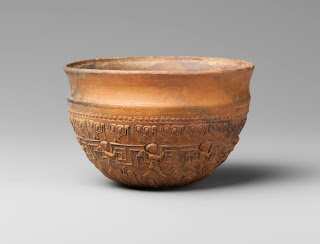ON THE IMPORTANCE OF POTTERY - FOUR
A brief note on how Pottery styles reflect cultural and technological changes
The Red figure White Ground and Black Figure Vessel of the Attic Classical era dwindled in production disappearing in the Hellenistic era..
The Cause? Probably Alexander's defeat of the Persians!
Other Causes? Yes. Read on.
With Alexanders defeat of the Persians Ionian and other Greek cities in Asia minor underwent a cultural revival. Athens was no longer the major cultural centre.
Wealth flowed into Greece. Returned soldiers spent money on metal.
The specialists who made handles and sprigs and painted the thrown vessels became painters of walls or makers of mosaics and ... an biggie! ... new developments in using molds allowed for mass production of objects like "Megarian" ware.
The Greek may have used molds prior to this to shape handles but using molds for mass production was something new!
I have done pottery and while I suck at throwing from what I learnt and bowls I have seen it seems like bowls were being thrown and then placed in molds to dry
However some potters and workshops in Athens used the "West Slope" style derived from black figure.
If we had just the pots and no literature or history texts we would know something happened in Greece and Asia Minor. Ceramics became less treasured. We know Roman collectors valued something called Corinthinian bronze and other gold and silver or glass objects which have not survived or survived in far lower numbers.
Ceramics however can not be melted down. You can grind them into small pieces for grog to stiffen clays but ...
Ceramics of course were still being made.
The Athenians and other mainland or Asia Minor Greek studios and workshops also had to compete with workshops in Southern Italy Tuscany and other places.
But South Italian pottery is a theme for another post!










